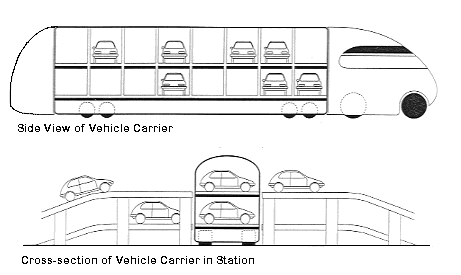Vehicle Mass Transit System (VMTS) - (aka Carbus)
The Vehicle Mass Transit System (also known as Autobus or Carbus) is a concept developed by Professor Andrew A. Frank at the University of California at Davis. It would utilize large trucks that operate on dedicated freeway lanes (e.g. HOV lanes) and carry several small vehicles from one station to another at speeds of around 60 mph. The main idea is to provide a means for substantially increasing the utilization of the existing freeway system while providing for high speed, stressless travel by persons riding in the comfort and privacy of their own vehicle. Of course, the cost of implementing such a system would be quite modest when compared to proposals for rail transit systems because the VMTS would be able to more fully utilize the existing freeway system. Moreover, the vehicles that would be used would be privately owned and maintained and the system itself could be owned and operated by a private company.
The following diagram shows two views of what the carrier vehicle might look like. It could be a diesel truck or be powered by some other type of engine. The trailer would provide several compartments for vehicles, most of which would probably be small electric vehicles slightly less than 10' feet in length. The next diagram shows how a station and loading platform might be configured. Existing freeway interchanges could be used, in some cases, as locations for VMTS stations, as illustrated in the next diagram.
![[VMTS loading station]](frank111.gif)
Professor Frank estimates that a carrier vehicle could be unloaded and reloaded at a station in 10-20 seconds. He suggests that the stations should be located about 10 miles apart. The theoretical maximum capacity is estimated to be 14,400 carried vehicles per hour assuming an average load of 20 vehicles per carrier with each carrier traveling at 100 feet per second and each carrier slot being 500 feet long (i.e. a 200' carrier vehicle and a 300' separation between carrier vehicles). Some on-board amenities are illustrated in the following diagram. Such amenities could be provided by the private company should they be desired by the persons using the system. In some areas, large numbers of small cars would have to be parked after exiting the system. Specially constructed parking structures might be needed in and could be built on lower cost land near major destinations. An illustration of an automated multistory carousel type of parking facility is shown in the diagram below. It would utilize that same structural element that is used for the trailer of the carrier vehicle.
![[passenger vehicle
amenities]](frank17.gif)
![[special parking facility
diagram]](frank12.gif)
The system would be designed to take full advantage of current communication and computing technologies. Reservations would be made by telephone or computer, giving the system your location, destination, desired time of boarding, energy requirements (e.g. charging of an electric vehicle), entertainment desires, etc. All of these requests need to be confirmed automatically and station space and carrier space reserved. Continuous updates would need to be made as you drive toward the station and transmitted to the approaching driver.
The concept includes provisions for large cars as well as small electric cars. The following diagram shows a pallet loading concept for dealing with large cars that would ride on the lower level of the carrier trailer. Rail cars could also be used where appropriate and the next diagram illustrates this idea. Service for persons arriving by bicycle could also be provided as shown in the next two diagrams.
![[large car pallet
loading]](frank16.gif)
![[rail cars used as
carriers]](frank14.gif)
![[bicycle transport on
carrier]](frank19.gif)
![[bicycle carrier design]](frank18.gif)
Professor Frank has done a preliminary sketch plan of a VMTS network for the Los Angeles region (top of the San Fernando Valley south to Newport, covering an area of around 10,000 square miles (i.e. 100 by 100 miles). He found that about 23 stations would be needed to provide a station spacing of around 10 miles in this region.
A similar concept, called the Personal Mass Transit System (PMT), has been devised by David Petrie of Petrie Transit Consultants in Seattle, Washington. Petrie's loading concept is different from that of Frank and requires large station facilities built over existing freeways. He also envisions an eventual conversion to a maglev system (like the Japanese HSST system) that would replace the trucks operating on existing lanes. As currently envisioned, only small electric cars like those now available in Europe would be carried (for an example, see the SMART car). Four illustrations from Petrie's work are shown below.
![[PMT station illustration]](pmt4.gif)
![[autoloader view from
loading platform]](pmt3.gif)
![[illustration of small
electric vehicle]](pmt2.gif)
![[HSST configuration]](pmt1.gif)
More details about the VMTS can be obtained from Professor Andrew A. Frank, Department of Mechanical and Aerospace Engineering, Room 2104 Bainer Hall, University of California at Davis, Davis, CA. 95616-5294. Phone: (916) 752-8120 (office); 752-4158; 752-0580 (office secretary); Fax: 752-4158; e-mail: aafrank@ucdavis.edu
More details about the PMT system can be obtained from Dave Petrie, Petrie Transit Consultants, 31416 36th Avenue SW, Federal Way, Washington Phone: (206) 661-0457; e-mail: davepetrie@comcast.net
Last modified: April 2, 2010
